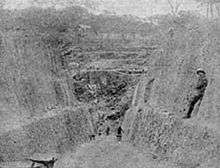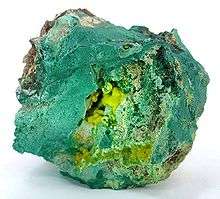Shinkolobwe
 Shinkolobwe mine, 1925 | |
| Location | |
|---|---|
 Shinkolobwe mine | |
| Location | Shinkolobwe |
| Province | Katanga |
| Country | Democratic Republic of the Congo |
| Coordinates | CD 11°03′S 26°33′E / 11.050°S 26.550°ECoordinates: CD 11°03′S 26°33′E / 11.050°S 26.550°E |
| Production | |
| Products | Uranium ore |
| History | |
| Closed | 2004 |


Shinkolobwe is a town and a mine in the Katanga province of the Democratic Republic of the Congo (DRC), located near the larger town of Likasi and about 120 miles northwest of Lubumbashi. Around 15,000 people live in the town.
The mine produced uranium ore for the Manhattan Project. It was officially closed in 2004.
History
The mineral deposit was discovered in 1915 by an English geologist Robert Rich Sharp (1881-1958).[1][2] The mine was worked from 1921 onwards. Uranium-bearing ore was initially exported to Belgium for the extraction of radium;[3] some of which was captured by Germany and postwar was transferred to Russia for the Soviet atomic bomb project.
Uranium for the Manhattan Project
The United States used Shinkolobwe's uranium resources to supply the Manhattan Project to construct the atomic bomb in World War II. Edgar Sengier, then director of Union Minière du Haut Katanga, had stockpiled 1,200 tonnes of uranium ore in a warehouse on Staten Island, New York. This ore and an additional 3,000 tonnes of ore stored above-ground at the mine was purchased by Colonel Ken Nichols for use in the project. Nichols wrote:[4]
- Our best source, the Shinkolobwe mine, represented a freak occurrence in nature. It contained a tremendously rich lode of uranium pitchblende. Nothing like it has ever again been found. The ore already in the United States contained 65 percent U3O8, while the pitchblende aboveground in the Congo amounted to a thousand tons of 65 percent ore, and the waste piles of ore contained two thousand tons of 20 percent U3O8. To illustrate the uniqueness of Sengier’s stockpile, after the war the MED and the AEC considered ore containing three-tenths of 1 percent as a good find. Without Sengier’s foresight in stockpiling ore in the United States and aboveground in Africa, we simply would not have had the amounts of uranium needed to justify building the large separation plants and the plutonium reactors.
The mine was closed in 1939 and flooded. The US Army sent a squad from its Corps of Engineers to reopen the mine, expand the aerodromes in Léopoldville (now Kinshasa) and Elizabethville (now Lubumbashi), and extend the port at Matadi, on the Congo River. Between 1942 and 1944, about 30,000 tons of uranium ore were sold to the US Army.
American interest in the Shinkolobwe mine for the purpose of developing of nuclear weapons led to the implementation of extensive security measures. Shinkolobwe's location was removed from maps and journalists were denied access to the mine and official information.
Postwar
Security measures were slightly more relaxed in the wake of World War II,[3] but in the 1950s, most journalists were able to gather only scraps of information on the mine's operation, from unofficial sources.[5][6] In 1950, a uranium processing plant was said to be under construction near the mine.[3] At the time, Shinkolobwe was believed to contain roughly half of the world's known reserves of uranium.[7]
Closure
The mine was officially closed on January 28, 2004, by presidential decree. However eight people died and a further thirteen people were injured in July 2004 when part of the old mine collapsed. Although industrial production has ceased with cement lids sealing off the mine shafts, there is evidence that some artisanal mining still goes on here. A United Nations inter-agency mission, led by the UN Office for Coordination of Humanitarian Affairs (OCHA) and the United Nations Environment Programme (UNEP), and organised through their Joint Environment Unit, visited the mine. The UNEP/OCHA concluded:
- Shinkolobwe is representative of similar situations in Africa and elsewhere in the developing world. A strong link exists between rural poverty, environmental protection and this type of livelihood activity. Alternative income opportunities must be developed and integrated in parallel to artisanal exploitation if new livelihood options are to be found for these rural poor. A holistic, multidisciplinary approach within the context of poverty alleviation is essential to address this problem and avoid further human and environmental catastrophes.[8]
"Uranium for Iran" allegation
On July 18, 2006, the DRC Sanctions Committee (United Nations Security Council Committee Established Pursuant to Resolution 1533 (2004), to give it its full name) released a report dated June 15, 2006, which stated that artisanal mining for various minerals continues at the Shinkolobwe mine:
- 149. During an investigation into alleged smuggling of radioactive materials, the Group of Experts has learned that such incidents are far more frequent than assumed. According to Congolese experts on radioactive materials, organs of State security have, during the past six years, confiscated over 50 cases containing uranium or cesium in and around Kinshasa. The last significant incident occurred in March 2004 when two containers with over 100 kilograms of stable uranium-238 and uranium-235 were secured.
- 150. In response to a request for information by the Group of Experts the Government of the United Republic of Tanzania has provided limited data on four shipments that were seized over the past 10 years. Unfortunately the Government chose not to provide information about the quantities of the seized consignments nor the specific method of smuggling. At least in reference to the last shipment from October 2005, the Tanzanian Government left no doubt that the uranium was transported from Lubumbashi by road through Zambia to the United Republic of Tanzania. Attempts via Interpol to learn the precise origin within the Democratic Republic of the Congo have remained inconclusive.[9]
On August 9, 2006, the Sunday Times published a report claiming that Iran was seeking to import "bomb-making uranium" from the Shinkolobwe mine,[10] quoting the UN report of July 18, 2006. It gives "Tanzanian customs officials" as its sole source for the claim that the uranium was destined for processing in the former Soviet republic of Kazakhstan via the Iranian port of Bandar Abbas. That has drawn comparison with the claim that Saddam Hussein was trying to buy yellowcake uranium from Niger, which formed part of the case made by George W. Bush for the invasion of Iraq.[11][12]
References
- ↑ (French) Robert Rich Sharp, En prospection au Katanga il y a cinquante ans, Elisabethville, 1956.
- ↑ Hogarth, Donald, Robert Rich Sharp (1881-1958): prospector, engineer, and discoverer of the Shinkolobwe, Katanga, (Congo) radium-uranium ore-body, Society for the History of Discoveries
- 1 2 3 "Uranium ore, copper pacing Congo's output. American capital to have part soon in Katanga projects". The News-Herald. Franklin, Pennsylvania. 1950-05-18. Retrieved 2015-01-16.
- ↑ Nichols, K. D. The Road to Trinity pages 44-47 (1987, Morrow, New York) ISBN 0-688-06910-X
- ↑ "Find world's richest uranium mines well guarded, output still a secret". Mansfield (Ohio) News-Journal. 1950-08-20. Retrieved 2015-01-16.
- ↑ Cassidy, Morley (1953-08-02). "The word that is never said". The Kansas City Star. Retrieved 2015-01-16.
- ↑ "Roughly half of the earth's uranium ore lies in the Belgian Congo". Daily Independent Journal. San Rafael, California. 1954-02-24. Retrieved 2015-01-16.
- ↑ The DRC and Uranium for Iran accessed August 19, 2006
- ↑ DOCUMENTS RELATED TO THE SECURITY COUNCIL COMMITTEE ESTABLISHED PURSUANT TO RESOLUTION 1533 (2004) CONCERNING THE DEMOCRATIC REPUBLIC OF THE CONGO
- ↑ Iran's plot to mine uranium in Africa Sunday Times, August 9, 2006
- ↑ African uranium redux Wayne Madsen Report. Retrieved August 18, 2006.
- ↑ The DRC and Uranium for Iran. Retrieved August 19, 2006.
External links
| Wikimedia Commons has media related to Shinkolobwe Mine. |